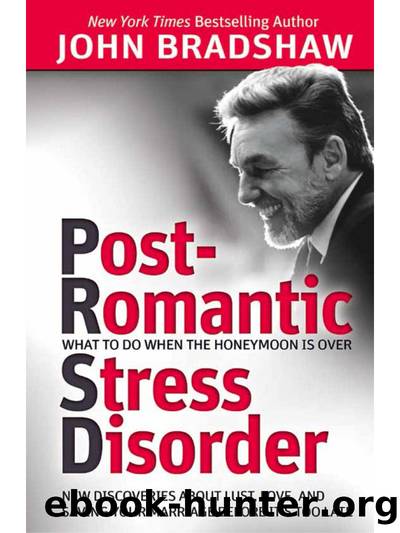Post-Romantic Stress Disorder by John Bradshaw

Author:John Bradshaw
Language: eng
Format: epub
Tags: honeymoon, over, new, discoveries, lust, love, saving, marriage, after, before, late
Publisher: Health Communications Inc
Published: 2014-10-01T00:00:00+00:00
Weâve already dealt with number 1, the false beliefs surrounding our understanding of the romance program. Most researchers see being in-love as a nonworking prelude to love, not love itself. Iâve discussed how the âlove moleculeâ dramatically raises each personâs sexual drive (testosterone level) and how in twelve to eighteen months, people more or less go back to their normal testosterone levels. The heightened state of the in-love stage is natureâs way of ensuring that we meet, mate, and reproduce, so that life will go on. It âdid not evolve to help us maintain a stable, enduring partnership,â as Helen Fisher wrote.
For the individuals who are or were in-love, the diminishment of the romance program can be an enormous jolt. It must be understood that the post-infatuation period, with its possible PRSD, is the end of the prelude to love and the beginning of the first stage toward experiencing real grown-up love. If you look at Chart 7C, Iâve outlined what I (and many others) believe are the three self-generating stages of maturing love, which begin when the in-love/lust stage (romance program) ends.
I use variations on the word dependency because I express the developmental stages of childhood as a struggle that starts with being co-dependent (symbiotically bonded with our mothering sources). From that we move to counterdependency, as we find our earliest sense of self by separating from our mothering sources. This is a stage of oppositional bonding. Toddlers fight for their selfhood by having tantrums and saying âNo!,â and a pure self-boundary statement, âItâs mine!â From the counterdependency struggle for separation and selfhood, in later childhood we begin to establish our unique independence. This is the adolescentâs struggle, par excellence. Teenagers often fantasize that they live with an âimaginary audienceâ watching them. Teenagers make a âpersonal fableâ starring themselves.
They must make their lives unique and special. In late teenage years, high school, or the early years of college, we generally fall in-love and find ourselves ensconced in the mirroring eyes of our beloved. We find ourselves in a symbiotic bonding for the second time. Once our in-love trance ends, we begin the journey to mature interdependence.
I believe the romance program is the starting point of mature love. It is a wondrous time for most people, but to confuse it with mature love has, as weâve seen, serious and potentially evil consequences.
In her book The Anatomy of Love, Helen Fisher discusses the length of marriage. For our ancestors, marriage seemed to last a very short time. In the animal kingdom, staying together for more than four years was unusual. This was enough time for the couples to have offspring and care for them. In four years, the offspring could fend for themselves. As marriage moved from being a political or social contract and merged with the in-love poetry and romance of the troubadours, it became a love affair.
As life expectancy grew beyond what ages had known in the past, we developed a new challengeâthe long-term marriage. We still have scanty knowledge of how enduring marriage is supposed to unfold.
Download
This site does not store any files on its server. We only index and link to content provided by other sites. Please contact the content providers to delete copyright contents if any and email us, we'll remove relevant links or contents immediately.
| Codependency | Conflict Management |
| Dating | Divorce |
| Friendship | Interpersonal Relations |
| Love & Loss | Love & Romance |
| Marriage | Mate Seeking |
The 5 Love Languages: The Secret to Love That Lasts by Gary Chapman(9683)
Doing It: Let's Talk About Sex... by Hannah Witton(9233)
Should I Stay or Should I Go? by Ramani Durvasula(7619)
The Road Less Traveled by M. Scott Peck(7549)
The Lost Art of Listening by Michael P. Nichols(7448)
Daring Greatly by Brene Brown(6469)
Beartown by Fredrik Backman(5662)
We Need to Talk by Celeste Headlee(5568)
Men In Love by Nancy Friday(5190)
The Rules Do Not Apply by Ariel Levy(4904)
The State of Affairs by Esther Perel(4687)
How To Win Friends and Influence People by Dale Carnegie(4466)
Reflections Of A Man by Mr. Amari Soul(4255)
Pillow Thoughts by Courtney Peppernell(4234)
The Ethical Slut by Janet W. Hardy(4206)
Algedonic by r.h. Sin(4034)
Surrounded by Idiots by Thomas Erikson(3889)
He's Just Not That Into You by Greg Behrendt & Liz Tuccillo(3855)
I Love You But I Don't Trust You by Mira Kirshenbaum(3834)
